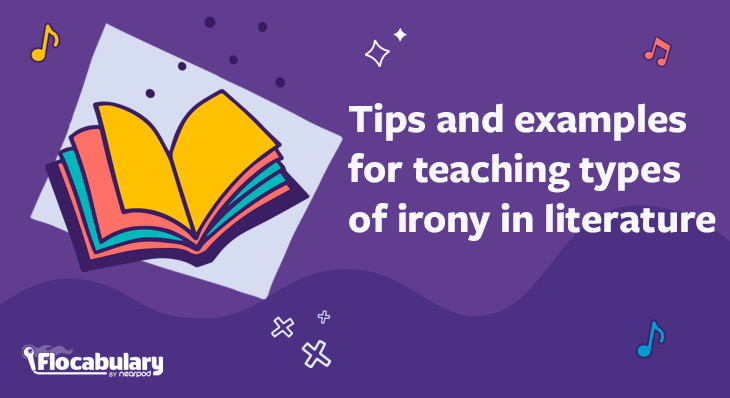
Tips and examples for teaching types of irony in literature
What is irony?
“Irony” is a literary device that appears in novels, short stories, plays, movies, and TV shows. Irony examples in literature and media create an unexpected twist at the end of a joke, or the tension that makes us fear a character in a scary movie. There are three types of irony: verbal, dramatic, and situational.
Teaching the three types of irony helps students develop critical thinking and analytic skills. In this post, we’ll discuss the three types, provide examples of them in literature, and offer instructional tips for teaching your students. We’ll also see how Flocabulary helps your students learn about literary devices and their importance in developing critical-thinking skills.
Captivate students and make learning experiences memorable and interesting through Flocabulary. Teachers can sign up below to access the activities and lessons shared in this blog post. Administrators can contact us below to learn more about the power of Flocabulary Plus.
Why is teaching literary devices important?
Literary devices are elements authors use to lay down clues and achieve specific effects. Imagery, symbolism, foreshadowing, allusions, and–of course–irony are all examples of literary devices.
Teaching about literary devices makes students better readers and writers; equipped with an understanding of these devices, they can appreciate what authors are doing and how they do it. Students then use those learnings in their own writing to better achieve the desired effects, and develop their own style and craft. Importantly, finding and analyzing literary devices requires the kinds of higher-order thinking skills students need to be critical and creative problem solvers and communicators.

For these reasons, literary devices show up frequently in K-12 standards. Texas’s TEKS curriculum standards for ELAR Middle School and High School are examples. In total, the term “literary device” shows up nine times!
Flocabulary’s literature lessons provide many opportunities to build students’ skills in finding and analyzing literary devices. These rich, multimedia video lessons provide engaging and relevant stories for students across all grades, like our lesson on Symbolism and The House on Mango Street. You can find even more with Flocabulary Plus!
What are the three types of irony?
- Verbal irony occurs when a speaker’s intention is the opposite of what they are saying. For example, a character stepping out into a hurricane and saying, “What nice weather we’re having!” In this case, what you’d expect them to say—and what they really mean—is the opposite of what’s being said.
- Dramatic irony occurs when the audience or reader knows a key piece of information or expects something the character does not. This type makes us yell, “Don’t go in there!” during a scary movie. It is often used in Shakespeare’s tragedies, famously in Othello and Romeo and Juliet, as we’ll discuss below.
- Situational irony occurs when the result of a situation is the exact opposite of what you’d expect. Sitcoms often use this. For example, a family spends a lot of time and money planning an elaborate surprise birthday party for their mother to show her how much they care. But, it turns out her birthday is next month, and none of them knew the correct date. She ends up fuming that no one cares enough to remember her birthday. Here’s a common misconception to watch out for: things that are just coincidental aren’t necessarily situational irony. Remember, it has to be more than just a coincidence but the opposite of what’s expected.
Tips and examples for teaching types of irony in literature
1. Introduce irony with Flocabulary’s video

You can kick off a lesson or mini-unit on irony using Flocabulary’s lesson to introduce the concept. Play the video and consider passing out the printable lyrics so students can follow along.
On the second time through, turn on Discuss Mode and have students discuss the prompts that come up in pairs or small groups. You can use the Read & Respond to give students practice reading and analyzing short passages, as well as identifying the literary devices used.
Watch the lesson video below with your students!
2. Conduct real-alouds in different tones
When it comes to verbal irony, a lot can be conveyed through tone. One instructional tip for teaching verbal is to have students read sentences out loud with a different tone.
For example: “That’s so sweet!” or “What a surprise!” Ask student volunteers to read these sentences as if they really mean what is being said. Then, ask them to read them as if they mean the exact opposite of what is being said. Take it one step further: have students write short scenes that could accompany each example, then act out those scenes in small groups for the class.
Another tip: clarify with students how sarcasm is related. Sarcasm is a type of verbal irony that intends to criticize; however, it can be used for other purposes too.
After these introductory exercises, you can work with students to analyze the effects of verbal irony in different works of literature, such as the examples below!
3. Teach verbal irony in Jonathan Swift’s A Modest Proposal
A Modest Proposal is a classic example of verbal irony. In this high school-level text, Swift begins seemingly in earnest, discussing the sad state of destitute children:
“[W]hoever could find out a fair, cheap, and easy method of making these children sound, useful members of the Commonwealth, would deserve so well of the public as to have his statue set up for a preserver of the nation.”
Seems reasonable enough. But things take a very ironic turn:
“I have been assured by a very knowing American of my acquaintance in London, that a young healthy child well nursed is at a year old a most delicious, nourishing, and wholesome food, whether stewed, roasted, baked, or boiled; and I make no doubt that it will equally serve in a fricassee or a ragout.”
Is Swift sincerely proposing that we eat children? No, but he has indeed inverted our expectations and written a wonderfully ironic essay. He suggests–ironically–that eating children is the only solution to poverty. What’s the effect of this form of verbal irony? He forces us to consider much more reasonable ways to address the issue! As you discuss this text, you can introduce the concept of satire and discuss how these literary technqiues help Swift make his real point clear.
Teaching comprehension and literacy skills
Flocabulary Mix and Break it Down* are powerful tools that teach students comprehension strategies and literacy skills.
Flocabulary Mix is a new feature that guides students through close viewing and analysis of Flocabulary videos. It includes two new video types:
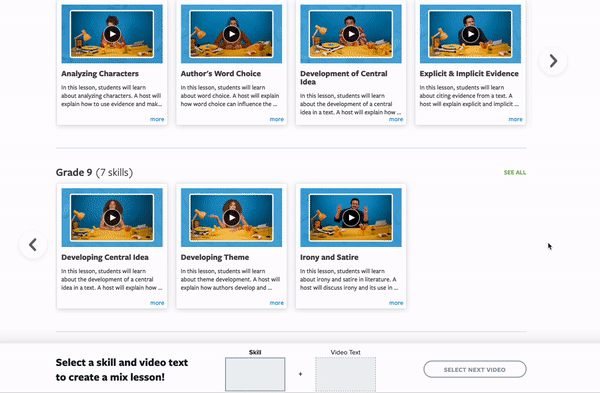
- Skill Videos are short videos that feature a host providing direct instruction (spoken, not rapped) of key comprehension and literacy skills.
- Video Texts are hip-hop videos made to be analyzed using these skills. These engaging nonfiction and fiction hip-hop videos cover diverse topics ranging from science and social studies, to original and existing fiction, art, technology, and music.
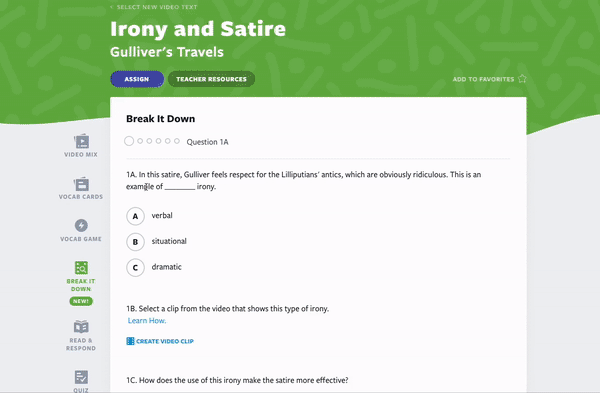
To teach about verbal, select the “Irony and Satire” skill video and choose a Video Text to go along with it. Once you create the Mix, you can assign the video to your class. You can also assign Break it Down. Break It Down is an analysis activity designed to help students develop and practice comprehension strategies and habits of evidence gathering. In these mixes, they’ll answer a multiple-choice question about these literary devices, find examples from the Video Texts, and analyze their effects in an open-ended response.
*Flocabulary Mix and Break it Down are available to users with a school or district Flocabulary Plus subscription.
4. Analyze Shakespeare’s Julius Caesar (Act 3, Scene 2)
Before this scene from Julius Caesar, Brutus addresses the crowd after Caesar’s murder. Brutus says he killed Caesar out of love for the republic and not out of hatred. And now, in scene two, Antony steps up to defend Caesar and to show that those who killed him are traitors. But he doesn’t say this directly. Instead, he uses irony to prove his point, repeating the line, “Brutus is an honorable man” four times. As he repeats this, the reader realizes he doesn’t mean what he’s saying. He means the opposite.
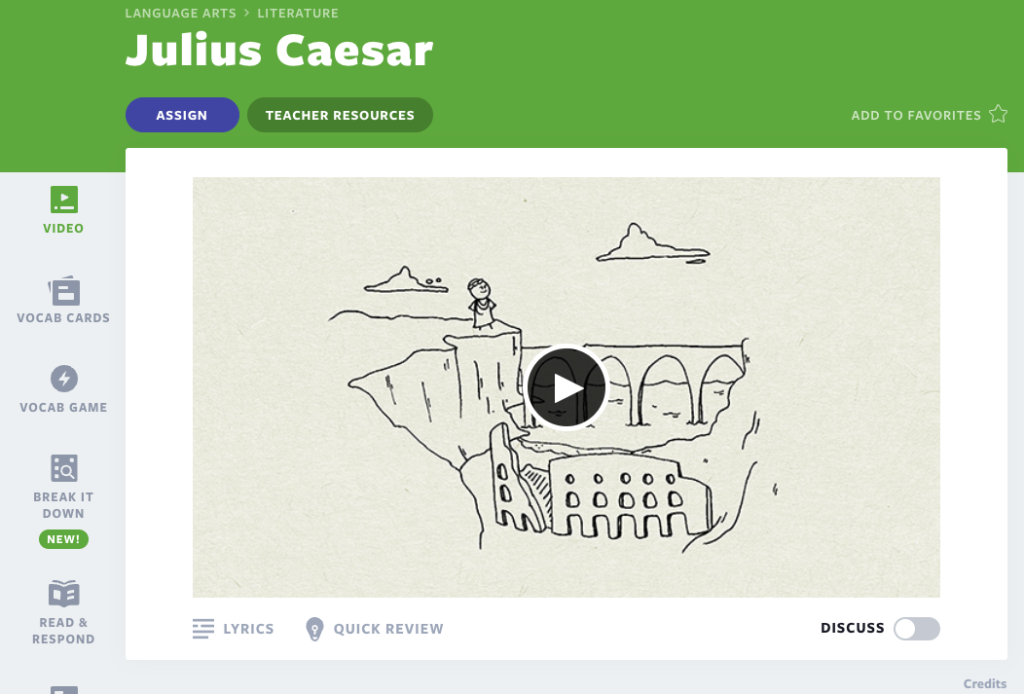
You can play the video from Flocabulary’s lesson on Julius Caesar to hear this monologue performed aloud to explore types of irony. This song covers Julius Caesar, act 3, scene 2. As Antony addresses the crowd of “Friends, Romans, countrymen,” students will notice powerful rhetorical devices and uses of irony. Use the Read & Respond with your students and further analyze the literary devices and their effects in this powerful scene. Discuss how repetition and verbal irony combine to great effect in the monologue.
5. Watch popular movie clips that are examples of dramatic irony
Because dramatic irony can add suspense, it’s frequently used in horror movies and other scary stories. One instructional tip for teaching dramatic is using popular movie clips. Any time we, the audience, want to shout, “Don’t open that door!” or “Turn around!” it’s because we know more than the characters do, and that’s creating suspense!
Have students stop and jot down, or turn and talk, at the cliffhanger or most suspenseful moment in the video clip or work of literature. They can discuss what makes them want to keep reading or watching, their emotions, and what questions they hope will be answered next. This quick activity will have them analyze the effect of this literary technique in real-time. It may even give them some ideas for using this literary technique to create tension in their own writing.
You can also spend time with students analyzing the effects of dramatic irony in different works of literature using the two tips below.
6. Highlight examples from Romeo and Juliet
In the final act of this archetypal love story, Shakespeare employs dramatic irony examples in literature to keep the audience on the edge of their seats.
Friar Laurence sends a messenger to tell Romeo about Juliet’s plan to put herself into a death-like coma. We watch in horror as the messenger fails to deliver this vital piece of information. And though we know that Juliet is not really dead, we see Romeo poison himself because he cannot live without her. The audience knows a lot more than these characters do the whole time, and the results of what they don’t know prove to be tragic.
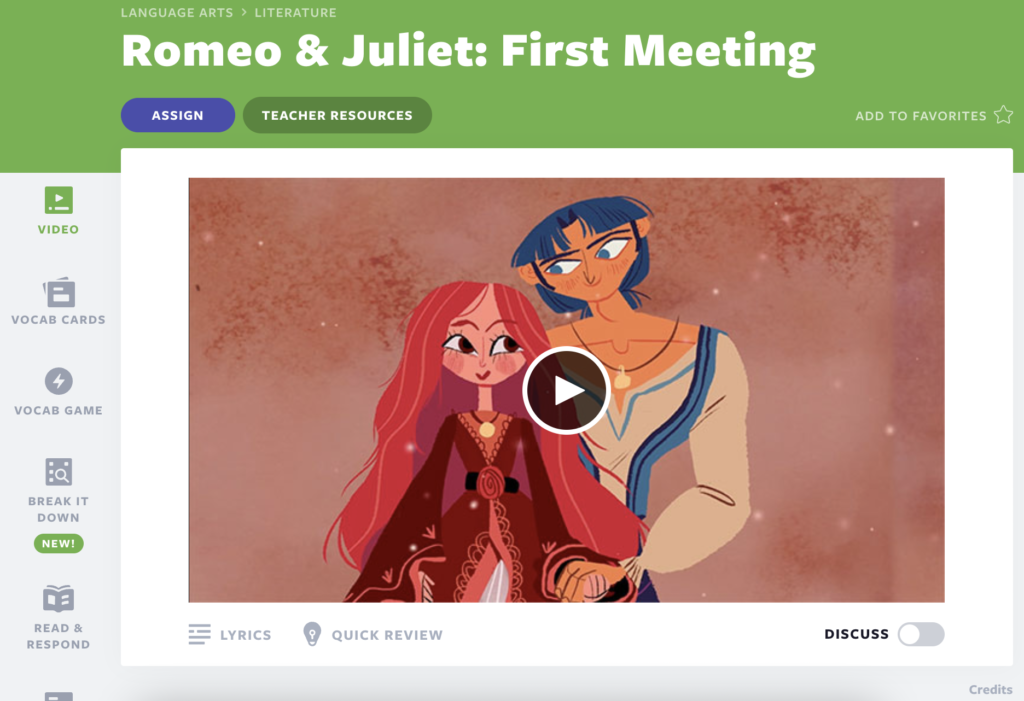
Have students read excerpts from the play’s last act and examine the dramatic irony occurring. Have them think through what information Romeo or Juliet could have learned that would change the entire outcome of the play and thus the message and effect it has on readers! To provide context and background information, watch Flocabulary’s Romeo & Juliet: First Meeting lesson video. In this song, we translate Shakespeare into a modern language to bring you the first dialogue between Romeo and Juliet.
7. Examine dramatic irony in Othello
Othello is one of the most heartrending tragedies ever written, and Shakespeare’s use of dramatic irony is one of the reasons the play is so powerful to read and watch.
We know that the handkerchief used as proof of Desdemona’s infidelity was, in fact, stolen by Emilia at Iago’s behest. Iago frames Desdemona, and we know she is innocent. But we are powerless to stop Othello; he has resolved to murder his wife.

Iago, whom Othello considers a friend, has been plotting Othello’s demise for the duration of the play. Othello does not know that Iago is the one pulling the strings, but we do. We know he is the one who convinces Roderigo to kill Cassio, even as we watch him pretend to help Cassio after he is wounded. Only we see Iago kill Roderigo before he can reveal the truth. In this way, we are complicit with Iago’s misdeeds. We are the only witnesses, and yet we can do nothing.
Flocabulary’s lesson on Othello includes the monologue from Act 5, Scene 2, performed dramatically and accompanied by an engaging video. You can play this video for students to help them understand the meaning of the Shakespearean language before you dive into a deeper analysis of the types of literary devices in the play.
8. Have students write a skit
Situational irony is often funny. In fact, it can be the basis for a whole comedy routine! One instructional tip for teaching situational irony is to have students devise a humorous example. Create a short writing prompt and have them practice humor writing based on their own original example. Maybe it’s a skit about a dentist who secretly hates flossing, or perhaps it’s about a restaurant called Just Soups advertising that they now serve salads! Have students share their skits with the class and discuss the example they were working with.
After that initial activity, you can dive into some literary examples in literature using the two tips below.
9. Highlight situational irony in O. Henry’s The Gift of the Magi
In O. Henry’s short story, The Gift of the Magi, a wife sells her hair to buy her husband a watch chain, and her husband sells his watch to buy her combs for her hair. Both have made sacrifices in order to buy gifts for one another, but in the end, the gifts are useless. The real gift is how much they are willing to give up to show their love for one another. As students read this short story, they can examine the effect of situational irony on the story and even practice writing their own short stories inspired by this classic tale.
10. Explore examples in Poe’s The Cask of Amontillado
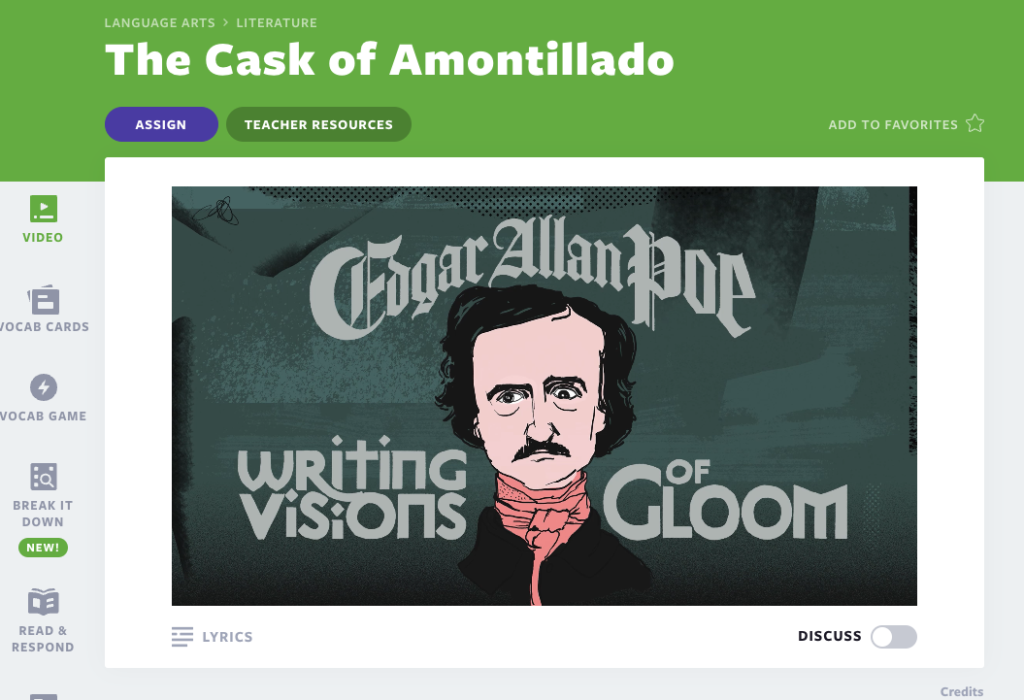
Situational irony involves being funny, but it can also be tense. Edgar Allan Poe is a master of all kinds of these literary techniques, including situational. You can use Flocabulary’s lesson on The Cask of Amontillado to see why. In this tale, there’s a character named Fortunato, meaning “good fortune.” However, he proves not to be lucky at all! He’s dressed as a jester but is not in for a celebratory evening. Students will follow the plot points and learn how Poe used irony and suspense to build a macabre mood.
Start teaching English Language Arts with Flocabulary
Irony is a literary device that can add depth and layers to a story. It can invert our expectations, create twists, and add suspense. Learning how irony is a figure of speech that can subtly shape narratives helps students understand its impact across literature and in their own communication. By learning about this, students can become better readers and writers as they appreciate the way literary devices create meaning and achieve intended effects. After exploring the examples outlined above, encourage students to use these literary devices in their own writing.
Flocabulary’s multimedia lessons are a great way to engage students in literature and to build the rigorous critical thinking and analytic skills they need to understand what they read. Our K-12 standard-aligned video-based lessons and activities leverage the power of hip-hop, storytelling, and emotional connections to cultivate literacy across the curriculum. Flocabulary is proven to strengthen a student’s understanding and highly engage them, ultimately leading to improved learner outcomes.
Captivate students and make learning experiences memorable and interesting through Flocabulary. Teachers can sign up below to access the activities and lessons shared in this blog post. Administrators can contact us below to learn more about the power of Flocabulary Plus.
